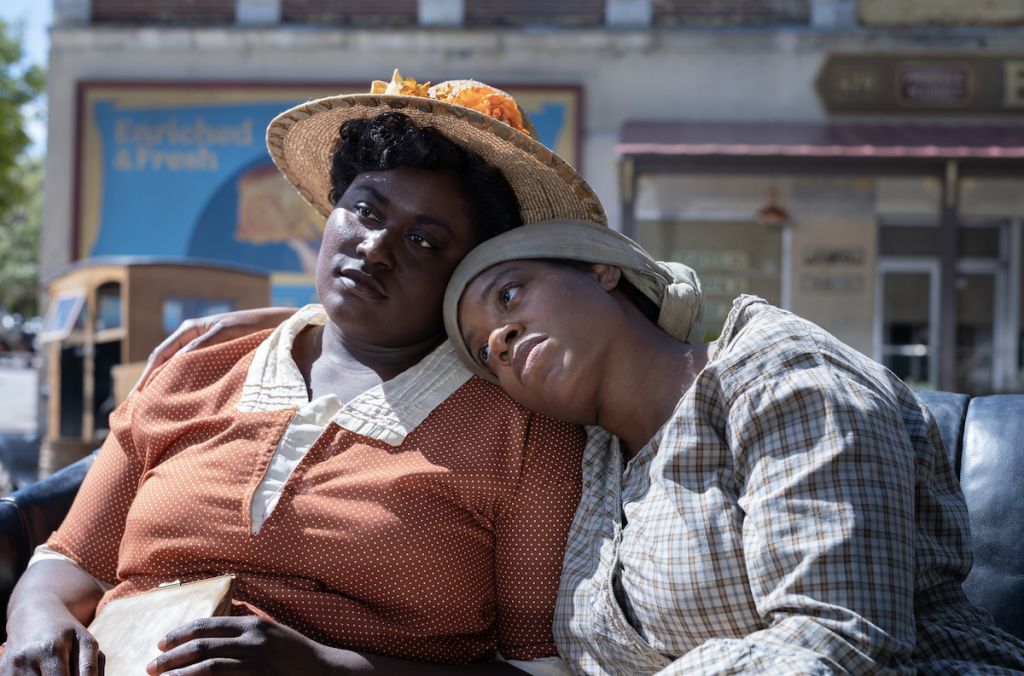Source: Courtesy / Warner Bros. Pictures
SPOILER NOTICE:
The following movie review does not contain direct spoilers for the film The Color Purple, however general information in regards to the plot, characters, key climax points and previous titles directly related to events in the film will be heavily discussed.
Please read at your own discretion, or after seeing the film in theaters.
Cooking up a proper remake or reboot to a classic, culturally-beloved film is not an easy feat — audiences loved the 1999 iteration of The Mummy starring Brendan Fraser; not so much can be said about the 2017 version starring Tom Cruise.
That’s why it came as a mixture of excitement, anticipation and admittedly a bit of trepidation as well when it was announced that The Color Purple, Steven Spielberg’s 1985 Oscar-nominated masterpiece starring Whoopi Goldberg and Oprah Winfrey in her film debut, would be getting a 2023 reboot based on the successful musical adaptation that ran on Broadway from 2005 to 2008 and again from 2015 to 2017.
The result is a beautiful new take on the powerful struggle story of Celie Harris Johnson, this time starring American Idol fave Fantasia Barrino as the aforementioned lead with stellar supporting performances by Taraji P. Henson, Danielle Brooks, Colman Domingo, Corey Hawkins, David Alan Grier and R&B sensations H.E.R. and Halle Bailey.
RELATED: Black Hollywood Showed Up for The Color Purple World Premiere
This version of The Color Purple, which has already received nominations at the Golden Globe Awards and Critics Choice Awards alike well before debuting in theaters today, isn’t too far off from the previous film. In addition to reuniting Spielberg, Winfrey and Quincey Jones on the production side, this film is actually more in line plot-wise with the original Pulitzer Prize-winning 1982 novel by Alice Walker. One key difference is the addition of music of course, with the random breaks into song inducing either eye-rolls or a stream of tears depending on the scene. There’s also a deeper exploration of the same-sex attraction between Celie and Shug Avery (Henson), which is alluded to in the original film but doesn’t go beyond a few gentle kisses. This time around, Fantasia and Taraji serve up intense intimacy and even share a bed at one point to let the audience know that it was, indeed, a sexual relationship.
Source: Warner Bros. Pictures
Source: Warner Bros. Pictures
Source: Eli Ade / The Color Purple
Thankfully, many highlights of The Color Purple neither begin nor end with the amazing performances of Fantasia and Taraji due in part to a phenomenal ensemble cast of Black Hollywood’s elite. Danielle Brooks is captivating in vocal prowess as well as emotional depth, while Colman Domingo is bone-chillingly good as prime antagonist Mister — for added measure, he’s also a spitting image of the character’s OG actor, Danny Glover. Similar to Winfrey in the original movie, H.E.R. did an impressive job in terms of her big screen film debut as Squeak, and writer Phylicia Pearl Mpasi gives an award-worthy performance in her acting debut as Young Celie. The other R&B divas added to the cast fair up pretty well too, from the unforgettable vocals of Fantasia in the lead and Tamela J. Mann as First Lady to Halle Bailey in her scene-stealing performance as Young Nettie. Ciara’s minor role as Adult Nettie on the other hand slightly vindicates her from the painful memory of Mama I Want To Sing! — slightly, very slightly.
Domingo is far from the only fella in the cast with impressive chops. Jon Batiste is great as Grady, Louis Gossett Jr. will make you want to sock him in the mouth based on how good he is as Ol’ Mister, Deon Cole wows in the supporting role of Alfonso, Corey Hawkins brings all the emotional depth to Harpo Johnson and David Alan Grier is almost unrecognizable (in a good way!) as Shug’s daddy, Rev. Samuel Avery.
Source: Courtesy / Warner Bros. Pictures
Source: Courtesy / Warner Bros. Pictures
Source: Courtesy Warner Bros. Pictures / The Color Purple
Source: Courtesy Warner Bros. Pictures / The Color Purple
Source: Eli Ade / The Color Purple
Source: Eli Ade / The Color Purple
Overall, this version of the decades-old story sits beautifully within The Color Purple multiverse — and yes, there’s a very special cameo appearance at the beginning that spiritually ties both films together and can be seen as a “baton passing” moment for sure. The core theme of Black sisterhood is highlighted tremendously, possibly moreso than ever before, and the men of the movie are allowed redemption in a way that was absent from the 1985 iteration, which you’ll see in stark detail with how Mister’s story plays out.
Unfortunately for some, a handful of fan-favorite lines from the original film are removed in the reboot for sensitivity sake. In short, don’t expect to hear Shug say, “You sho’ is ugly!”
This film is far from that.
Head to theaters on this beautiful Christmas Day to see The Color Purple, officially in theaters today. Peep the trailer below to get yourself in the singing spirit:
Review: ‘The Color Purple’ Does Justice To Remakes, Musicals And Black SisterhoodTaraji P. Henson Will Play Iconic Role Of Shug Avery In ‘The Color Purple Musical’ MovieSongstress H.E.R. Added To ‘The Color Purple’ Movie Musical Cast
The post Review: ‘The Color Purple’ Does Justice To Remakes, Musicals And Black Sisterhood appeared first on Black America Web.

